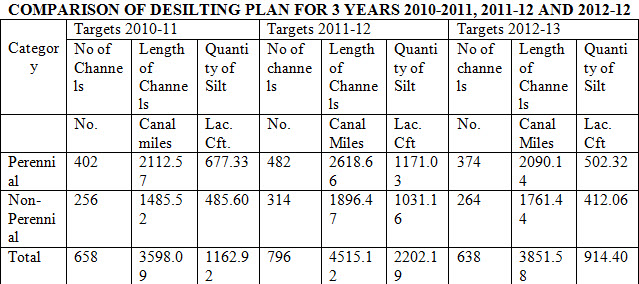Agriculture is main source of income for most of Pakistanis as Pakistan is blessed with strong agricultural potentials of diverse nature. About 70 percent of its people reside in rural and remote hinterlands where they mostly earn their livelihood from different agricultural related activities. Agriculture sector in Pakistan is dependent on water which mostly comes through a complex network of small and large canals. It’s heartening to bring up that Pakistan has the distinction of having the largest contiguous gravity flow irrigation system in the world. The irrigation system serves as a lifeline for sustainable agriculture in this part of the world having arid to semi-arid climate. The irrigated lands contribute more than 90 percent of agriculture production which accounts for 22 percent of GDP and employment of 54 percent of labour force. Punjab, being the main breadbasket, fulfills most of the country’s much needed food-grain and other sources of raw materials for major domestic industries, particularly cotton products, which accounts for 80 percent of the value of Pakistan’s total exports.
Punjab’s vast irrigation system is controlled through a well-designed network of 14 barrages constructed on the river Indus and its tributaries at Jhelum, Chenab, Ravi and Sutlej rivers under various projects constructed during 18th century to recent past of renowned gigantic works under Indus Water Treaty (1960). These rivers carry a substantial quantity of silt-load deposited in the distributaries and minors where velocity of flow is comparatively low-concept, but the requisite velocities are difficult to attain in the tail-reaches due to flat country-slope. The canal water supplies to the tail-portions of these distributaries and minors are, thus, adversely affected and the farmers located at the tail-reaches suffer serious shortages of canal-water leading to high rouse and unrest in the farming community.
Various water related studies conducted by the Punjab Irrigation Department revealed that siltation of channels adversely affects the distribution of canal supplies in two ways: firstly, it reduces the channels’ carrying capacity and secondly, the outlets located in the head-reaches start drawing more water than their authorized share due to raised water levels. Regular desilting of channels has, therefore, becomes a regular feature to mitigate this sore problem. It’s important to mention that a recent study conducted by a Chinese firm shown that storage capacity of Pakistan’s famous Tarbela Dam (built in 1978) has declined from 9.6 million acres feet (MAF) to about 6.6 MAF only. This happened due to continuous silting and sedimentation.
Punjab Irrigation Department (PID) started desilting of canals during the regime of late chief minister Ghulam Haider Wyne in 1990s and made it an annual feature. Since then, PID gregariously conducts this campaign to clean its canals of silt and other garbage. Canals in Punjab not only provide water for agricultural purposes but also useful for producing electricity. Punjab Irrigation Department has identified as many as 317 suitable points on canals where small and medium size hydro power plants can be installed and cheap electricity can be provided to the national grid. Their multifarious use like this has made them a national asset. As Punjab is the food basket of the whole country, therefore any investment here would benefit the whole of Pakistan.
While giving a detail of this year’s desilting plan, Mr. Najam Abbas Najmi Manager Communication & Education of Punjab Irrigation & Drainage Authority (PIDA) said that desilting plan 2012-13 was compiled from the data prepared by various irrigation zones of the Irrigation Department. He added that the plan includes desilting of 638 channels covering 3851.58 canal miles length and excavating 914.40 Lakh Cft earthworks with expected expenditure of Rs. 244.31 Million. The desilting plan was being implemented as a concerted campaign in two phases as per closure schedule notified by the Director, Indus Water Treaty & Regulation, Irrigation Department. He further told that desilting work on Mangla Command Canals was held between 26.12.2012 to 13.01.2013 (except Upper Jhelum Canal, Lower Chenab Canal and Upper Bahawalnagar Canal) whereas desilting work on Tarbela Command Canals commenced on 13-01-2013 and it’s expected to be concluded on 31-01-2013 (except Taunsa Canals).
The provincial secretary irrigation Mr. Khalid Masood Chaudhry told this scribe that desilting campaign was going on smoothly. He expressed the hope that it will significantly assist to clean the canals as arduous efforts are made to get the canals and other minors rid of the silt and other solid waste materials which comes in many shapes. Desilting helps the farmers, especially at the tail-ends, he added. “In order to ensure satisfactory completion of the cleanliness tasks assigned to the department, necessary instructions, along with quality control mechanism/checks, have already been conveyed to the field formations. The department is resolute to accomplish the task in the most professional manner.”

Keeping in view the extraordinary importance of desilting of canals, it’s essential that this exercise should be conducted with full verve and professional competence so that it could help in continuous flow of canals and ensure availability of water at tail-ends. Otherwise, our canals will be heavily silted; making them redundant and useless for the farmers. Another important point is sensitization of the general public to participate in it. Besides Irrigation Department officials, local people associated with the agriculture should be motivated through media to take part in it so that targets could be achieved well in time.













